SIGMA 150-600mm F5-6.3 DG OS HSM | Contemporary

• Eerste hypertelezoom uit de Contemporary-lijn
• Licht en compact
• Water- en olieafstotende coating op het voorste glaselement maakt het onderhoud van het lensoppervlak eenvoudiger. Stof- en spatwaterdichte montage
A robust specification offering both maneuverability and usability.
While lightweight, this model offers robust core functionality for use in a wide variety of photographic scenes. The result is a super-telephoto lens with outstanding performance.
This lightweight lens is easy to carry and use in a wide variety of photographic scenes. At the same time, as may be expected of a member of our high-performance Contemporary line, this lens features all the core functionality you need for your photography, including dust and splash resistant structure, a zoom lock switch that can be set for any focal length, a water- and oil-repellent lens coating, an easily accessible AF/MO/MF switch, and a newly designed tripod socket. This lens is also compatible with Sigma’s newly developed teleconverters (sold separately), with which it offers AF up to F8.
Water and oil-repellent coating helps ensure performance in all conditions.
The foremost lens elements feature a water- and oil-repellent coating that allows water to be wiped away easily and prevents oil and fat from sticking to the surface, even in challenging shooting conditions. This coating also makes maintenance of the lens surface easier.
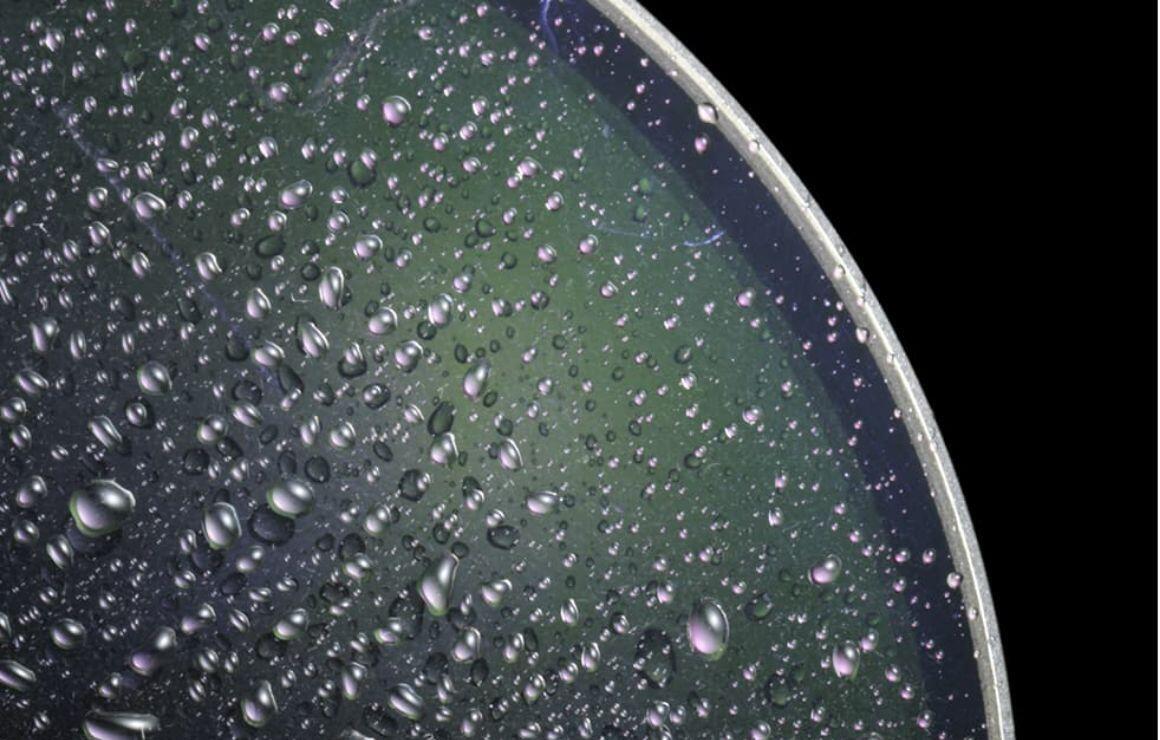

Without coating
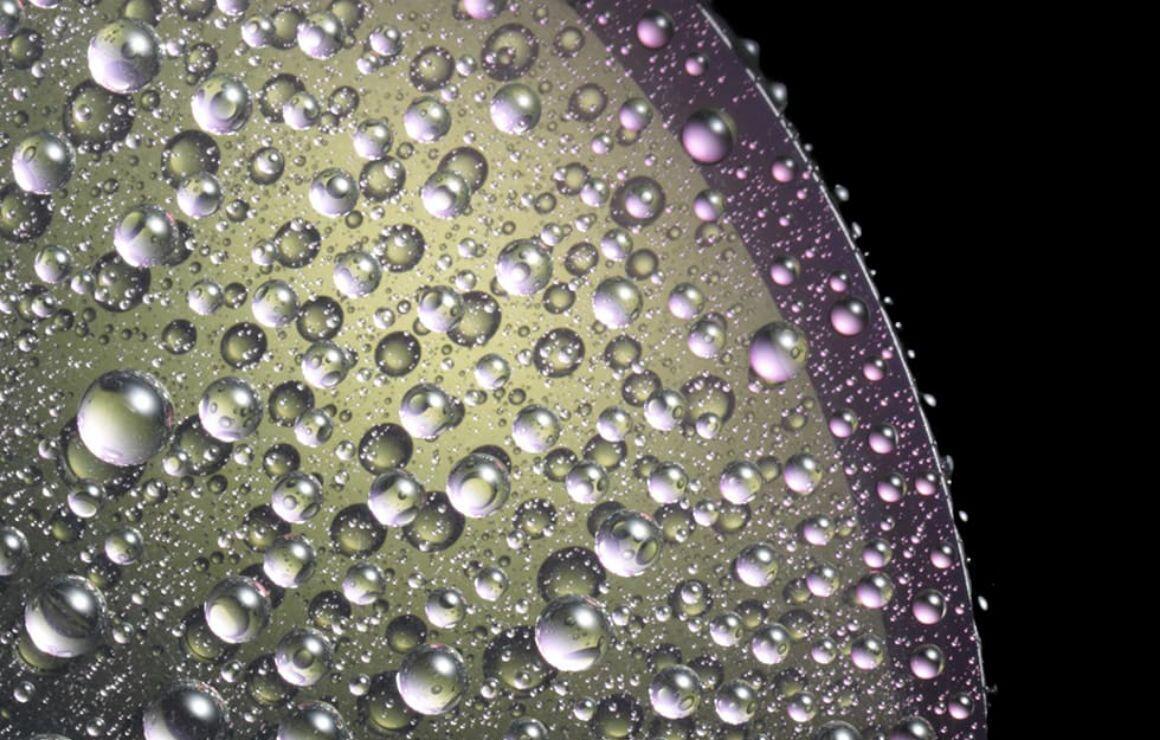

With coating
Mount with Dust and Splash Resistant Structure
As with the Sigma 150-600mm F5-6.3 DG OS HSM | Sports from the Sports line, the lens mount incorporates rubber sealing to protect the mount from dust and water drops.
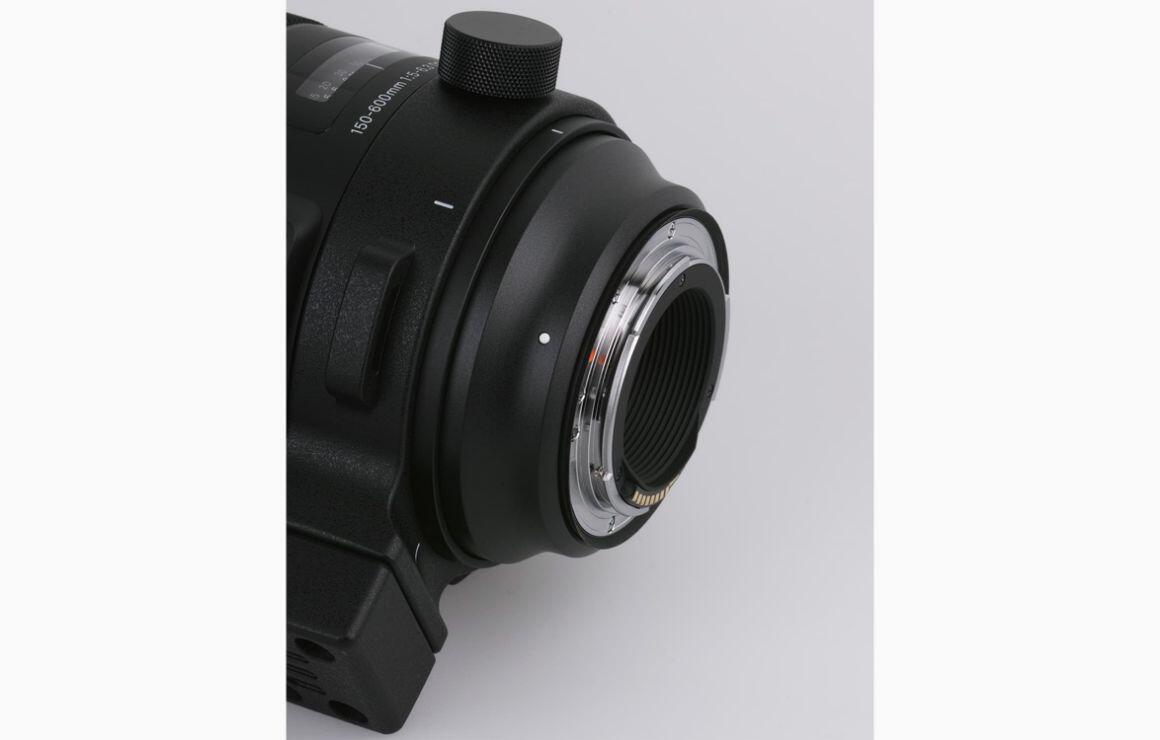

Intelligent OS featuring updated algorithm.
The OS (Optical Stabilizer) function features an acceleration sensor to ensure even higher precision. Two OS modes are available: Mode 1 for general photography and Mode 2 for motor sports and other applications requiring panning. In Mode 2, the acceleration sensor teams up with the Intelligent OS and its updated stabilization algorithm to deliver effective stabilization while you move the camera horizontally, vertically, or diagonally—regardless of the position of the lens. This feature helps ensure effective panning and outstanding capture of moving subjects.
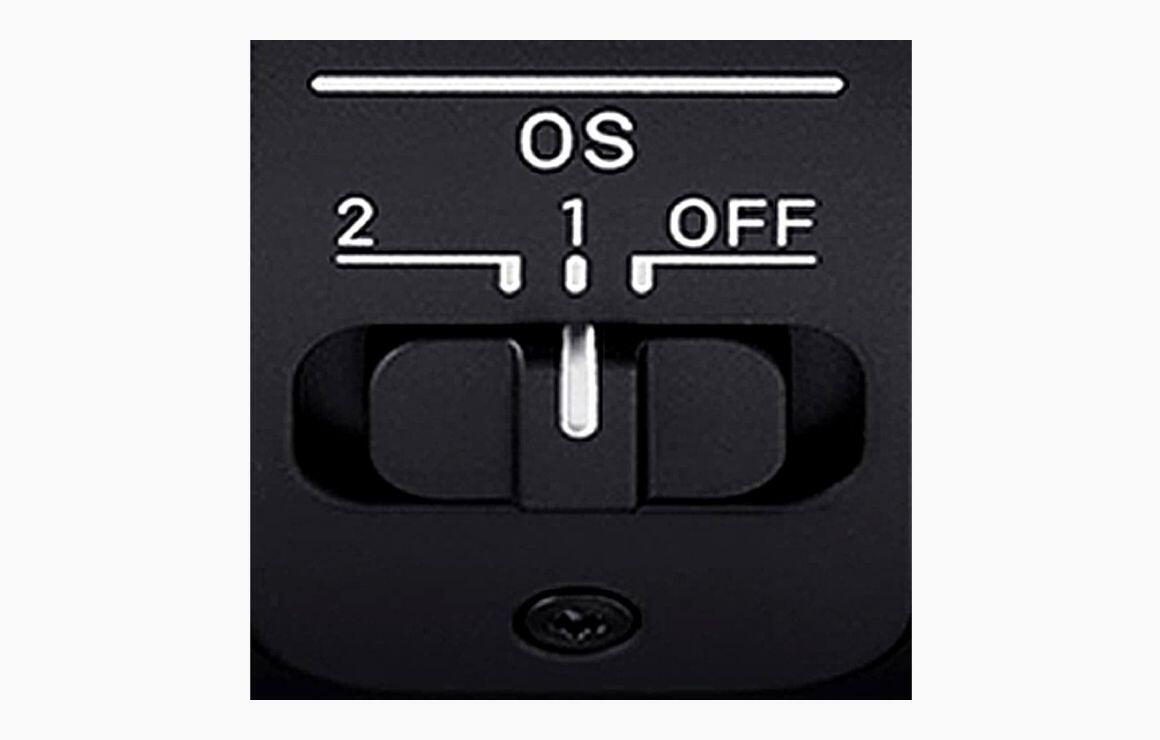

Two full-time manual modes available, including manual override.
In addition to AF and MF, MO (Manual Override) is available as an option via the focus mode switch. When the switch is set in the MO position, the lens may be switched to manual focus simply by rotating the focus ring—even during continuous AF. In the AF position, standard full-time manual focus remains available. With the Sigma USB DOCK (sold separately), you can easily customize the degree of twist sensitivity in MO mode.


Zoom lock switch that can be set at any focal length.
The new zoom lock switch enables the zoom ring to be locked at any focal length. It can be fixed at the photographer’s desired focal length, which allows stable shooting even when the lens is positioned upward or downward. This feature is also useful during long-exposure photography.
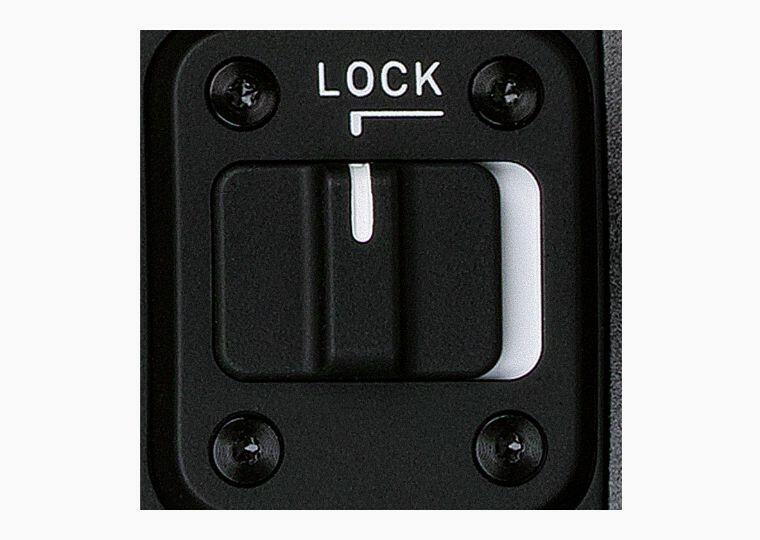

Quieter and faster optimized AF
The HSM (Hyper Sonic Motor) ensures high speed and quiet AF. Enhancing the drive algorithm applied in previous models, Sigma has enhanced focus accuracy in autofocus continuous (AF-C) mode by 5 percent.
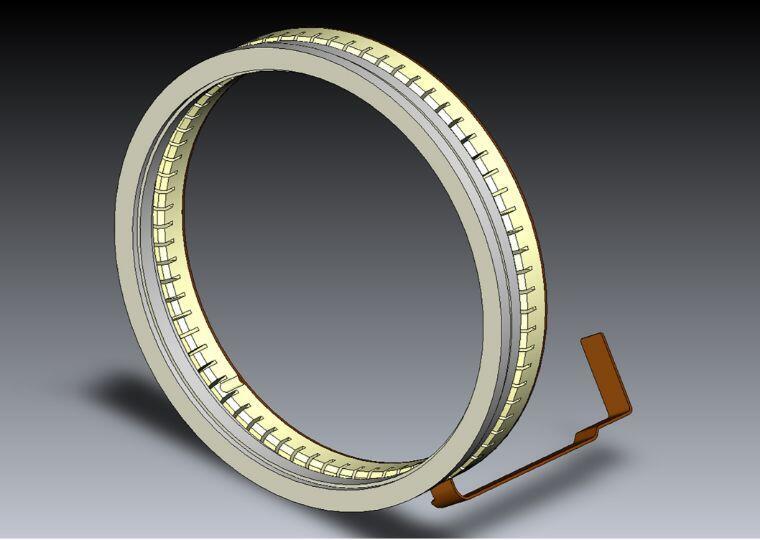

High-precision, rugged brass bayonet mount
The brass mount combines high precision with rugged construction. Its treated surfaces and enhanced strength contribute to the exceptional durability of the lens.
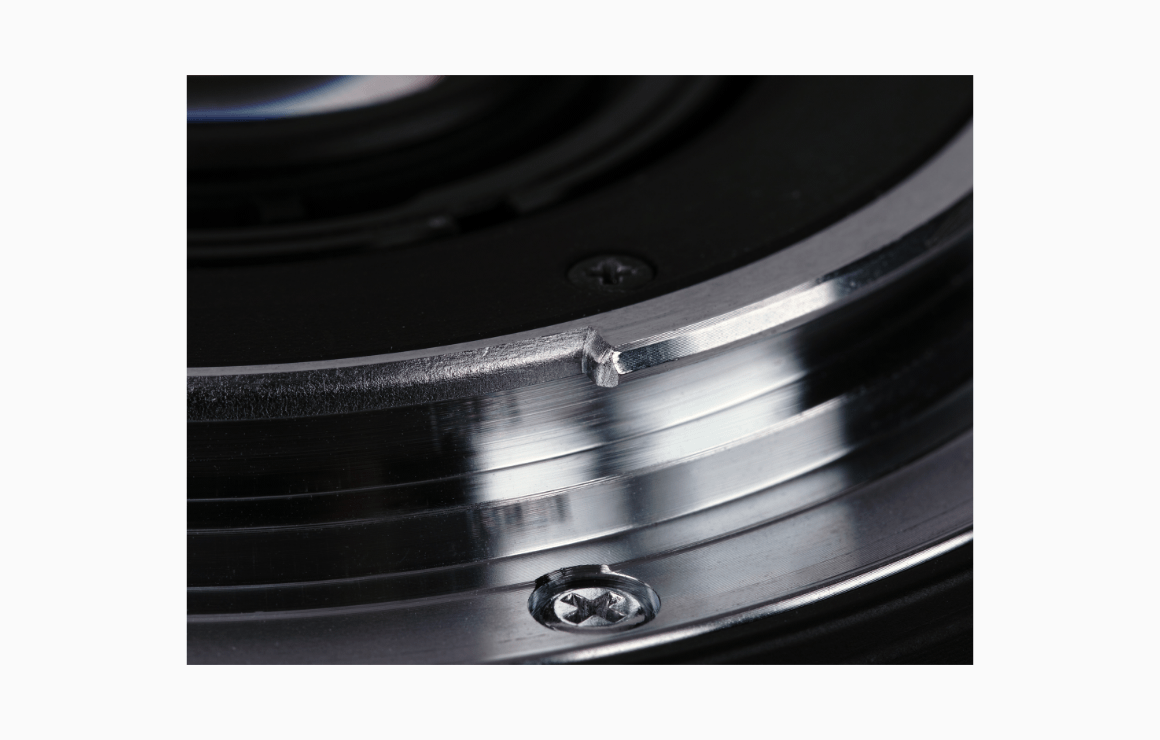

TSC (Thermally Stable Composite)
Conventionally it is considered essential to leverage the qualities of metal and polycarbonate in camera and lens layout design. A first for the industry, the barrel of the new series of Sigma lenses features a new (*)TSC (Thermally Stable Composite) that offers minimal thermal shrinkage combined with exceptional hardness. Since its thermal shrinkage is low, TSC matches well with metal parts, further contributing to the high-precision construction of the lens.
TSC (Thermally Stable Composite) is a type of polycarbonate with a thermal expansion rate similar to that of aluminum. It has high affinity to metal parts which contributes to high quality product manufacturing.
Featuring enhanced usability, this lens offers the outstanding optical performance of SIGMA’s Contemporary line.


Minimized transverse chromatic aberration—thanks to FLD and SLD glass lens elements.
This lens features one (*)FLD (“F” Low Dispersion) glass element, which offers performance equivalent to fluorite, and three SLD (Special Low Dispersion) glass elements to minimize chromatic aberration. In particular, the low-dispersion glass elements and optimized power distribution help minimize transverse chromatic aberration, which can tend to affect the telephoto end and cannot be reduced by adjusting focus. The end result is outstanding image quality throughout the zoom range.
FLD glass is ultra-low-dispersion glass that offers performance of the highest level. Highly transparent, its refractive index and dispersion are extremely low as compared to conventional types of glass. It offers characteristics very similar to those of fluorite, which is valued for its anomalous dispersion. These characteristics minimize residual chromatic aberration (secondary spectrum), which cannot be corrected by ordinary optical glass, while helping to produce sharp, high-contrast images.
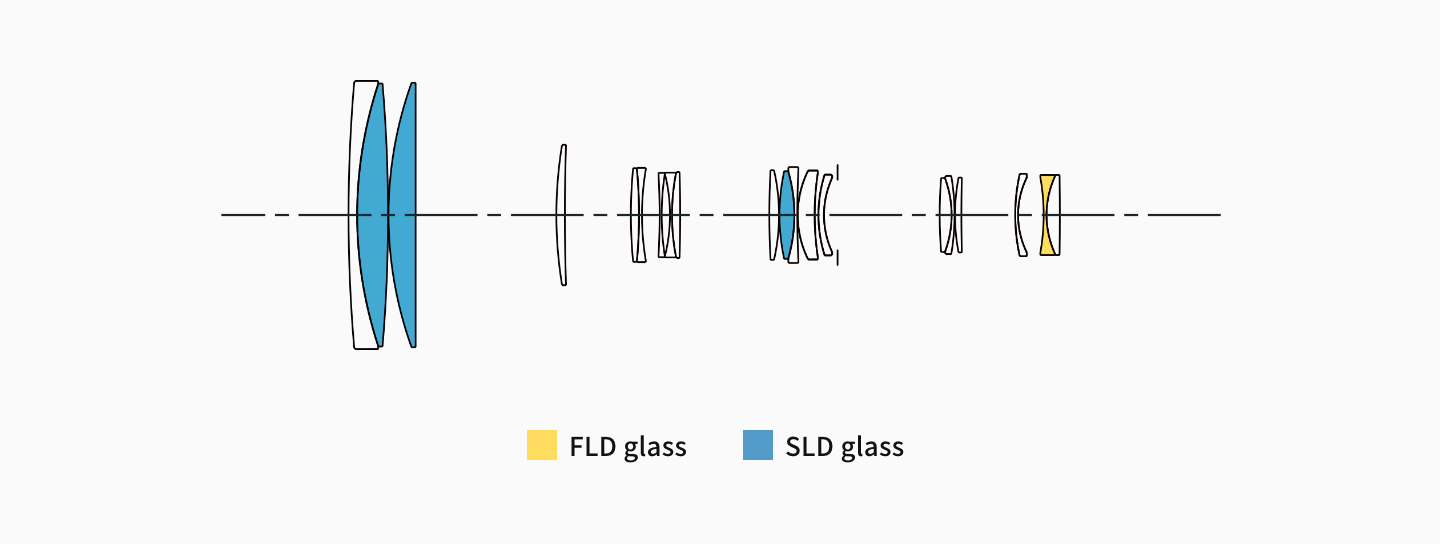

Flare and ghosting reduction
From an early stage in the lens design process, flare and ghosting have been measured to establish an optical design resistant to strong incident light sources such as backlighting. Sigma’s Super Multi-Layer Coating reduces flare and ghosting to help photographers produce sharp and high contrast images even in backlit conditions. The included lens hood can be attached to block out extraneous light, which can have a negative effect on rendering performance.


Exclusive low-dispersion glass
The degree to which light is refracted by glass depends on the light’s wavelength. This fact causes different colors of light to focus at slightly different points. The result is chromatic aberration, the color fringing that is particularly noticeable in telephoto lenses. Most chromatic aberration can be removed by combining a high-refractivity convex lens element with a low-refractivity concave element. Yet residual chromatic aberration known as “secondary spectrum” may still remain. To minimize this secondary spectrum, which can be a serious issue with conventional lenses, Sigma lenses feature up to three types of exclusive low-dispersion glass offering superior performance: ELD (Extraordinary Low Dispersion), SLD (Special Low Dispersion) and FLD (“F” Low Dispersion). In particular, FLD glass offers ultra-low dispersion in combination with high transmittance and the anomalous dispersion characteristics of fluorite. Meticulous deployment of these types of exclusive low-dispersion glass and optimization of power distribution gives Sigma lenses superlative image rendition undiminished by residual chromatic aberration.
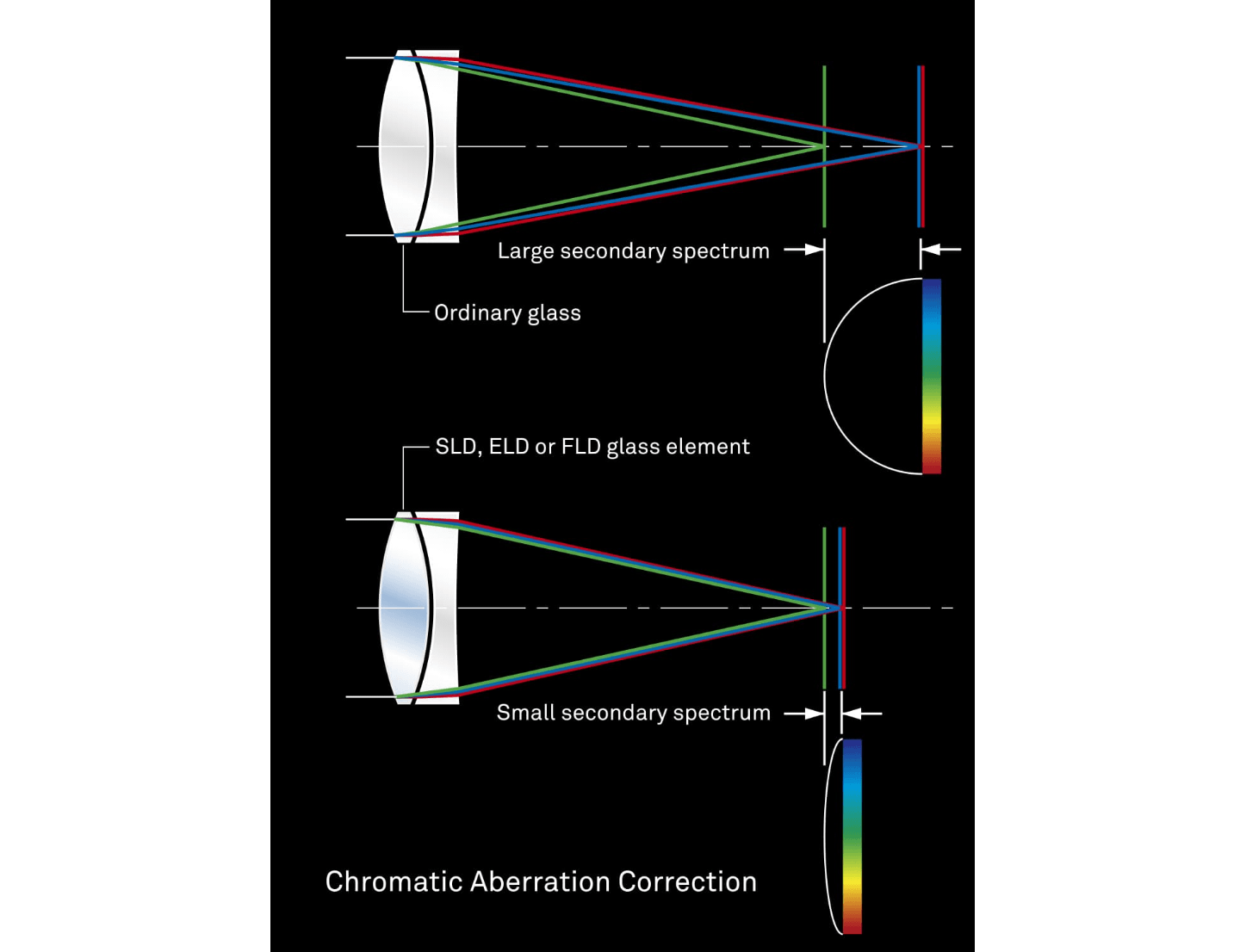

Rounded diaphragm
When photographing with point light sources such as electric lights or reflections on a body of water in the background, the rounded 9-blade diaphragm helps produce an attractive bokeh effect—even at large-aperture settings.


Newly designed Teleconverters that enables AF to be effective up to F8
Teleconverters that are newly designed to match the new lens line-ups can be attached. The addition of Sigma’s TELECONVERTER TC-1401 or TELECONVERTER TC-2001 produces a MF 210-840mm F7-9 hyper-telephoto zoom lens or a MF 300-1200mm F10-12.6 hyper-telephoto zoom lens respectively. In addition, when Sigma TELECONVERTER TC-1401 is attached to cameras that are compatible with AF at F8, it is possible to shoot with AF.
*When shooting subjects with low contrast or luminosity value, focus may not be spot on the subject.


| Productlijn | Contemporary | |
|---|---|---|
| Youtube Videos | ||
| Instagram Widget | ||
| Klevu Image | /c/0/c015_150_600_5_63_basic_01.png | |
| Lensconstructie | 20 Elements in 14 Groups | |
| Lens Type | Telephoto | |
| Sensor Size | Full Frame | |
| Beeldhoek | 16.4º - 4.1 º | |
| Aantal diafragmalamellen | 9 (Rounded Diaphragm) | |
| Minimaal diafragma | F22 | |
| Minimale scherpstelafstand | 280 cm / 110.2 in. | |
| Maximale vergroting | 1:5 | |
| Afmetingen (diameter x lengte) | ||
| Gewicht (gram) | 1930 g / 68 oz. | |
| Filtermaat | 95mm | |
| Edition number | C015 | |
| Accessoires | Lens hood (LH1050-01) supplied | |
| EAN-code | Canon E/EF 085126745547 |
|
A robust specification offering both maneuverability and usability.
While lightweight, this model offers robust core functionality for use in a wide variety of photographic scenes. The result is a super-telephoto lens with outstanding performance.
This lightweight lens is easy to carry and use in a wide variety of photographic scenes. At the same time, as may be expected of a member of our high-performance Contemporary line, this lens features all the core functionality you need for your photography, including dust and splash resistant structure, a zoom lock switch that can be set for any focal length, a water- and oil-repellent lens coating, an easily accessible AF/MO/MF switch, and a newly designed tripod socket. This lens is also compatible with Sigma’s newly developed teleconverters (sold separately), with which it offers AF up to F8.
Water and oil-repellent coating helps ensure performance in all conditions.
The foremost lens elements feature a water- and oil-repellent coating that allows water to be wiped away easily and prevents oil and fat from sticking to the surface, even in challenging shooting conditions. This coating also makes maintenance of the lens surface easier.


Without coating


With coating
Mount with Dust and Splash Resistant Structure
As with the Sigma 150-600mm F5-6.3 DG OS HSM | Sports from the Sports line, the lens mount incorporates rubber sealing to protect the mount from dust and water drops.


Intelligent OS featuring updated algorithm.
The OS (Optical Stabilizer) function features an acceleration sensor to ensure even higher precision. Two OS modes are available: Mode 1 for general photography and Mode 2 for motor sports and other applications requiring panning. In Mode 2, the acceleration sensor teams up with the Intelligent OS and its updated stabilization algorithm to deliver effective stabilization while you move the camera horizontally, vertically, or diagonally—regardless of the position of the lens. This feature helps ensure effective panning and outstanding capture of moving subjects.


Two full-time manual modes available, including manual override.
In addition to AF and MF, MO (Manual Override) is available as an option via the focus mode switch. When the switch is set in the MO position, the lens may be switched to manual focus simply by rotating the focus ring—even during continuous AF. In the AF position, standard full-time manual focus remains available. With the Sigma USB DOCK (sold separately), you can easily customize the degree of twist sensitivity in MO mode.


Zoom lock switch that can be set at any focal length.
The new zoom lock switch enables the zoom ring to be locked at any focal length. It can be fixed at the photographer’s desired focal length, which allows stable shooting even when the lens is positioned upward or downward. This feature is also useful during long-exposure photography.


Quieter and faster optimized AF
The HSM (Hyper Sonic Motor) ensures high speed and quiet AF. Enhancing the drive algorithm applied in previous models, Sigma has enhanced focus accuracy in autofocus continuous (AF-C) mode by 5 percent.


High-precision, rugged brass bayonet mount
The brass mount combines high precision with rugged construction. Its treated surfaces and enhanced strength contribute to the exceptional durability of the lens.


TSC (Thermally Stable Composite)
Conventionally it is considered essential to leverage the qualities of metal and polycarbonate in camera and lens layout design. A first for the industry, the barrel of the new series of Sigma lenses features a new (*)TSC (Thermally Stable Composite) that offers minimal thermal shrinkage combined with exceptional hardness. Since its thermal shrinkage is low, TSC matches well with metal parts, further contributing to the high-precision construction of the lens.
TSC (Thermally Stable Composite) is a type of polycarbonate with a thermal expansion rate similar to that of aluminum. It has high affinity to metal parts which contributes to high quality product manufacturing.
Featuring enhanced usability, this lens offers the outstanding optical performance of SIGMA’s Contemporary line.


Minimized transverse chromatic aberration—thanks to FLD and SLD glass lens elements.
This lens features one (*)FLD (“F” Low Dispersion) glass element, which offers performance equivalent to fluorite, and three SLD (Special Low Dispersion) glass elements to minimize chromatic aberration. In particular, the low-dispersion glass elements and optimized power distribution help minimize transverse chromatic aberration, which can tend to affect the telephoto end and cannot be reduced by adjusting focus. The end result is outstanding image quality throughout the zoom range.
FLD glass is ultra-low-dispersion glass that offers performance of the highest level. Highly transparent, its refractive index and dispersion are extremely low as compared to conventional types of glass. It offers characteristics very similar to those of fluorite, which is valued for its anomalous dispersion. These characteristics minimize residual chromatic aberration (secondary spectrum), which cannot be corrected by ordinary optical glass, while helping to produce sharp, high-contrast images.


Flare and ghosting reduction
From an early stage in the lens design process, flare and ghosting have been measured to establish an optical design resistant to strong incident light sources such as backlighting. Sigma’s Super Multi-Layer Coating reduces flare and ghosting to help photographers produce sharp and high contrast images even in backlit conditions. The included lens hood can be attached to block out extraneous light, which can have a negative effect on rendering performance.


Exclusive low-dispersion glass
The degree to which light is refracted by glass depends on the light’s wavelength. This fact causes different colors of light to focus at slightly different points. The result is chromatic aberration, the color fringing that is particularly noticeable in telephoto lenses. Most chromatic aberration can be removed by combining a high-refractivity convex lens element with a low-refractivity concave element. Yet residual chromatic aberration known as “secondary spectrum” may still remain. To minimize this secondary spectrum, which can be a serious issue with conventional lenses, Sigma lenses feature up to three types of exclusive low-dispersion glass offering superior performance: ELD (Extraordinary Low Dispersion), SLD (Special Low Dispersion) and FLD (“F” Low Dispersion). In particular, FLD glass offers ultra-low dispersion in combination with high transmittance and the anomalous dispersion characteristics of fluorite. Meticulous deployment of these types of exclusive low-dispersion glass and optimization of power distribution gives Sigma lenses superlative image rendition undiminished by residual chromatic aberration.


Rounded diaphragm
When photographing with point light sources such as electric lights or reflections on a body of water in the background, the rounded 9-blade diaphragm helps produce an attractive bokeh effect—even at large-aperture settings.


Newly designed Teleconverters that enables AF to be effective up to F8
Teleconverters that are newly designed to match the new lens line-ups can be attached. The addition of Sigma’s TELECONVERTER TC-1401 or TELECONVERTER TC-2001 produces a MF 210-840mm F7-9 hyper-telephoto zoom lens or a MF 300-1200mm F10-12.6 hyper-telephoto zoom lens respectively. In addition, when Sigma TELECONVERTER TC-1401 is attached to cameras that are compatible with AF at F8, it is possible to shoot with AF.
*When shooting subjects with low contrast or luminosity value, focus may not be spot on the subject.


Lens Construction
MTF Chart
High-precision, rugged brass bayonet mount
The brass mount combines high precision with rugged construction. Its treated surfaces and enhanced strength contribute to the exceptional durability of the lens.
Mount with Dust and Splash Resistant Structure
The lens mount incorporates rubber sealing to protect the mount from dust and water drops.
Water and oil repellent coating
Incorporates a water and oil-repellent coating that allows water to be wiped away easily and prevents oil and fat from sticking to the surface, even in challenging shooting conditions. At the same time, the maintenance of the lens surface becomes easier.
Zoom lock switch (Can be set at any indexed focal length)
This zoom lock switch enables the zoom ring to be locked at any indexed focal length. It can be fixed at the photographer's desired focal length, which allows stable shooting even when the lens is positioned upward or downward. This feature is also useful during long-exposure photography.
HSM (Hyper Sonic Motor)
The Hyper Sonic Motor (HSM) is an original SIGMA development that uses ultrasonic waves to drive the autofocus mechanism. Its extremely quiet operation helps avoid disturbing photographic subjects. High torque and speed assure rapid autofocus response. SIGMA uses two types of HSM: ring HSM and micro HSM. The Ring HSM configuration permits manual fine tuning of focus (manual override) by turning the focusing ring after autofocus is complete.
Rounded diaphragm
The polygonal shape of a conventional iris dia phragm causes out-of-focus light points to appear polygonal. A rounded diaphragm is designed to pro duce rounded out-of-focus light points when opened to near maximum aperture. This creates attractive bokeh effects in many situations, such as when pho tographing a subject against an out-of-focus surface of water from which light is being reflected.
Intelligent OS
Intelligent OS is an algorithm specially designed for panning shots. It enables effective image stabilization even when the camera is moved vertically or diagonally, regardless of the horizontal and vertical orientation. This feature is available on all of SIGMA's telephoto lenses that have OS switches 1 and 2, with the exception of the SIGMA 120-300mm F2.8 DG OS HSM | Sports.
Exclusive low-dispersion glass
The degree to which light is refracted by glass depends on the light's wavelength. This fact causes different colors of light to focus at slightly different points. The result is chromatic aberration, the color fringing that is particularly noticeable in telephoto lenses. Most chromatic aberration can be removed by combining a high-refractivity convex lens element with a low-refractivity concave element. Yet residual chromatic aberration known as "secondary spectrum" may still remain. To minimize this secondary spectrum, which can be a serious issue with conventional lenses, SIGMA lenses feature up to three types of exclusive low-dispersion glass offering superior performance: ELD (Extraordinary Low Dispersion), SLD (Special Low Dispersion) and FLD ("F" Low Dispersion). In particular, FLD glass offers ultra-low dispersion in combination with high transmittance and the anomalous dispersion characteristics of fluorite. Meticulous deployment of these types of exclusive low-dispersion glass and optimization of power distribution gives SIGMA lenses superlative image rendition undiminished by residual chromatic aberration.
